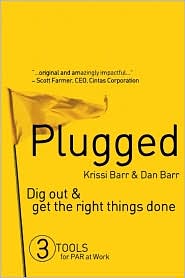 Have you ever met anyone that energized you just by exchanging emails? Krissi Barr is one of those rare individuals whose energy transcends the mere Internet connection.
Have you ever met anyone that energized you just by exchanging emails? Krissi Barr is one of those rare individuals whose energy transcends the mere Internet connection.
I hadn’t heard of Plugged before but when I saw the reviews on Amazon—36 in total; 35 of them 5-star—I knew there was a story to share. This book is obviously challenging more than a few people in a special way.
It’s a modern day business parable where golf figures prominently. It also happens to illustrate the key principals Krissi applies to her work in leadership coaching and team development.
1. Have you used “stories” in your consulting before? Why use golf?
Plugged is the first fable I’ve used in my consulting practice. The reasons golf was used are many. The first is that golf is a game of integrity. It’s a game you play with others and with yourself…just like business…you’re part of a team and also have to perform individually. If you fluff the ball, take too many mulligans, are you doing the same behaviors at the office?
You can learn much about a person by how they play golf…no matter whether they have a low or high handicap. And the statistics about golf and business are impressive:
- $28B in business is attributed to relationships on the golf course (H. MacKay).
- Golf is a $73B (2009) industry with a total impact to U.S. economy of $195B (PGA & Golf Digest) – that’s larger than the music and movie industries combined!
- There are 140K golf fundraising events raising $3.5B (2007).
- Companies run by good golfers perform above average (Fortune). The best 200 CEO golfers in 2006 have an average handicap of 10.7. The average handicap for all amateurs is 15 for men and 28 for women (USGA).
- Of 401 executives surveyed for a Starwood Hotels study in 2002, 92% said golf is “a good way to make new business contacts.” 97% said that golfing with a business associate “is a good way to establish a close relationship.” And 43% of executives said some of their biggest business deals were made on golf courses. (Washington Post)
- A Business Leader Poll by COMPAS found 80% of the executives surveyed agreed that golf is an important part of some business cultures and business relationships are nurtured there.
Companies and people hire me to help them get the right things done. I hear “we’re not as profitable as we should be”, “all we do is sit around in meetings and talk about things…we don’t actually implement our plans”, “employees aren’t engaged”.
Why do I hear those things? Because companies and people are stuck and not where they could be. 70% of companies have a strategic plan and only 10% implement that plan. When I work with a company, we not only develop their strategic plan…we implement. And we do so by first determining what’s most important, then changing behaviors and practices and finally holding ourselves accountable to implement.
These patterns worked beautifully with being “plugged” or stuck initially and using PAR (Prioritize, Adapt, be Responsible) for digging out and getting the right work done.
 2. How has writing this book changed your practices’ focus?
2. How has writing this book changed your practices’ focus?
Writing Plugged has not changed my consulting practice’s focus, rather it described what I was already doing with customers.
In 2004, I was asked to work with two country clubs to help them transition from a “club” to a “business” and their staff from “managers” to “leaders”. My husband (and co-author, Dan) and son were golfers and I was not. For years they asked me to play with them. Working with the two clubs gave me the opportunity to start playing.
One day, I was playing with Dan and Andy and I swung above the ball and then hit into the ground. I proudly claimed “I can stop playing this “f” game (and the “f” word wasn’t “fun”). Our son said “Mom, would you let your clients give up on their goals?” “Well no, but that’s different because it’s business.” I replied. “Mom – you have a goal of playing golf with Dad and me for the rest of your life. If you give up, you are living a lie in your business.”
That hit hard and he was right. So I started applying what I do with clients to help them get their business goals done to my golf game. I prioritized – meaning I made time twice a week for the driving range, once a week for 18 holes and once a week for lessons. I adapted – meaning I changed my schedule to allow time for all the golf activity and I changed my workouts to be more flexibility oriented. I was responsible – meaning I didn’t miss any golf training activities. And now I can occasionally break 100 and have tremendous fun with clients and most of all my family!
Writing Plugged changed my personal life much more than it did my business practice!
3. The story is set inside a corporation. Do some of the same fundamentals apply to a retiree, or even a college student? How can it help them?
The fundamental tools learned in Plugged—Prioritize, Adapt and be Responsible—are just as important to non-business readers. The concepts are universal.
In some ways, they are more important to anyone who doesn’t work in a structured organization. Those people—students, homemakers, retirees—don’t have the built in support that business people have. They’re on their own. The PAR process works in business, life and golf!
With the three tools in Plugged—and the free online tools—they can gain tremendously from the same thought process that is helping companies get the right things done.
4. Tell us about a client and how the book has helped them.
A client that is using the Plugged process owns approximately 50 fast food franchises. Last year, we developed their strategic plan using PAR. For leadership training, they had all company and restaurant management read Plugged. This was followed by a training session where every person had to identify several things including:
- How do you & your company live your corporate vision and culture?
- Where are you & where should you be spending your time? What should you stop doing, continuing doing and start doing?
- What are the top 3 – 5 goals you, your team, your company want to accomplish? What would be amazing performance?
- How do you need to adapt to change & trends?
- Company of the future – How are your customers changing & how are you & your company going to meet those needs?
- What are responsible behaviors & which ones do you need to do better, both for employees & customers?
- How can you & your company improve communications & build trust?
That client is having a record 2011 in terms of profits, the team has embraced the new culture and vision, and there’s a real focus on not just being busy, but being busy on the right activities.
5. You have several companion tools available on your website. Why and how are they necessary? Can they help someone even if they haven’t read the book?
There are two free tools available on www.pluggedthebook.com. While it would be better to have read the book, that is not a prerequisite for using the tools.
The first is the Online Assessment Tool that tells you how “plugged” you are. Respond to the 18 questions and get an instant analysis on how effective you are at prioritizing, adapting and being responsible.
The second free tool is the PAR Business Scorecard. This tool helps you plan what you need to do then implement them. It does this by following the PAR methodology by identifying your top priorities, the things you need to do to adapt and change, and who is responsible for getting them done. The PAR Business Scorecard can be downloaded and used for an individual or an entire organization.
6. In your book Trident is the customer and AlphaMax is the service provider. When AlphaMax realizes that might loose their biggest customer you take the reader on a journey of self-discovery, both for the protagonist and AlphaMax. What would be your advice to AlphaMax if the golfing public was Trident and golf industry leadership was AlphaMax.
The beauty of PAR (Prioritize, Adapt, be Responsible) is its universality. In your scenario, the golf industry is faced with the challenge of potentially losing their most important constituent, the golfing public.
Let’s hope this never happens, but if it did, the golf industry would start by identifying their top priority, namely identifying why they are losing players. Once identified, that new discovery becomes their top priority. Then they would work on adapting: get going on the specific actions the industry needs to change to turn around the situation.
Finally, they need each member of the team to know what they are responsible for and commit to doing everything they have to turn things around.
Krissi Barr and Dan Barr are dynamic business leaders, avid golfers, and first-time authors. Krissi is president and founder of Barr Corporate Success, a business consulting firm specializing in business strategies and leadership coaching to achieve maximum profitability for a wide range of clients from country clubs to international multi-billion dollar organizations. Dan Barr is a senior executive at business services leader, Cintas.